#prehispanic universe
Explore tagged Tumblr posts
Text
Binni Záa, Cap. 5 Coqui Xee - Señor del Tiempo
youtube
#youtube#méxico#mexico#binni záa#binni zaa#zapotec#zapoteco#universos prehispánicos#prehispanic universe
0 notes
Text
preliminary thoughts on the kingdom trailer:
where does it take place?
the people have tattoos and obey taboos regarding tattooing; speak tagalog; seemingly believe in multiple gods and spirits; and have shorn hair.
tattooing culture (and the shameful connotations of being without tattoos) was noted amongst visayans whom the chroniclers called pintados. tattooing was not present in manila and surrounding areas at the same time, likely owing to incoming muslim influences which linked the rajahs ache and soliman to the sultanate in brunei.
however, the royal family speak tagalog and they employ the use of babaylans/catalonans. the doylist explanation for this (for now) is that the writers simply mashed different prehispanic cultures together. the watsonian explanation is that there could have been a de-conversion of the royal family from islam back into animism/syncretism with dharmic religions. maybe there was visayan influence once upon a time which led to non-muslim, tattoo-wearing katagalugan. maybe there was a conflict between luzon and brunei. maybe both.
how did they escape colonization?
this is the interesting part. since the kingdom was modeled after thailand, it seems that it is given that whoever the monarch was in the 19th/20th century had collaborated with european and/or american powers to avoid total subjugation hence the name the kingdom of kalayaan? this could also explain why the king's children all have some european/white ancestry.
however, this doesn't answer for the earlier centuries' avoidance of colonization by the spaniards, british, portuguese, dutch, and french. the main reason why the philippines was so coveted was because of its proximity to china, the spice islands, and other asian lands from across new spain AKA mexico. did the rest of luzon and visayas do what the sultanates in mindanao did to keep their freedom? had luzonites collaborated with japan in curbing european presence in the so-called hermit kingdoms, e.g., catholic proselytizing? was the whole of southeast asia generally protected against european colonial powers and if so, how? what events in europe, mainland asia, and the americas caused certain events to happen which discouraged or disempowered the european age of exploration?
what is the extent of the kingdom of kalayaan?
the kingdom seems to be tagalog-centric; is it just in luzon and surrounding areas? assuming the muslim south survived just as it does in this universe, were their lands incorporated into the kingdom in agreement with the sultans and datus or did it go in a way similar to the real world, by filipinos building upon previous colonial american aspirations in mindanao & displacing the indigenous muslim and non-muslim peoples in favor of filipinization? are the secessionist groups in the film an allusion to the real secessionist groups in the past? what of the igorots, aeta, etc in luzon?
3 notes
·
View notes
Note
Congrats on your graduation! If you’re okay with answering, can I ask what drew you to archeology and how you knew that was the field you wanted to work in/study? Sorry for asking, I’m just real nosy and interested when it comes to ppl sharing their studies lol
hello! sorry that this is latest possible response but thank you so much for your congratulations!
my mum was a hobbyist archaeologst when she was younger, and she used to make me watch time team as a child to get me to sleep (which, if you're not familiar, is just a bunch of british archaeologists going around doing insane things to heritage sites. there's lots on youtube, i recommend it). i maintained an interest in history but i didn't consider it as a career in the slightest until i went to south america when i was 21, and i visited the cementerio de chauchilla while staying in nazca, which is a 7th century (i think?) prehispanic burial site. someone gave us a tour of the area, and he told us that he was studying archaeology for his post grad and he chatted to us for ages about it, and when we went back to the place we were staying in, i looked up university courses straight away. it was a very lightbulb moment for me. i dropped out of college a few years before so i could help my parents pay the bills, so i had to go through a bunch of shit to get into uni at all, but its been the only constant in my life, ever haha.
i cant explain why i had such unshakable faith in the field, because i have wanted to do a lot of different things in my life, but when i realised i could actually be an archaeologist, it's been the only thing ive wanted ever since. my interest is particularly in maritime archaeology and early modern european expansion, but i've studied a huge range from early human evolution, prehistoric vietnam, right through to colonial america and late victorian industrial. im planning on doing my postgrad next year in maritime archaeology, and working in academia hopefully!
8 notes
·
View notes
Text
Field School to Colombia
Day 1
Huerta Santa Helena and movement workshop
We started the day with a body movement workshop led by Prof. Oscar Mauricio Moreno. He started with a few exercises inspired by the Teather of the Oppressed (OdT), originally created by the Brazilian dramaturg Augusto Boal (1931-2009). The first approach of the movement helped us break the ice among students and have a sense of the university campus Gorge Tadeo. This workshop informed my final project since it deeply made me think about embodiment and space. Considering a sensorial and physical approach to social engagement. I was really happy to experience this workshop.
Afterwards, we visited the Huerta Santa Helena in the San Martin downtown neighbourhood. The urban farming project was led and founded by Helena Villamil, who was born and raised in the La Perseverancia neighbourhood. In this urban oasis, she developed an urban farm where workshops and food banks happen. Originally conceived as a restaurant serving organic produce, the project evolved into what is nowadays a space of resistance and agricultural activism. She welcomed us by giving a brief introduction to her philosophy and history with the lot, which is resisting the gentrification process, which is rapidly evolving through tall buildings surrounding the garden. She prepared a meal where all the food was organically produced, and from this holistic perspective we learned more about how she started 13 years ago.
First, she cultivated tomatoes and corn, which started her intimate process of learning and understanding food not only as a source of nutrition but spirituality. By communicating with the soil, the plans as silent but living beings that carry wisdom. She expressed her mission to liberate the seeds, not through a bank but through a depository that can be disseminated and shared with the population, making and developing urban farming. She does not depart from an industrial perspective but from a domestic approach where individuals can be more conscious about their relationship with food and the personal cultivation of herbs, veggies, and fruits. For me, this was one of the most significant activities since Prof. Oscar and her are collaborating on a project involving embodiment and farming as a holistic approach to connection with the earth. Ecologically speaking, it proposes a factual action of sustainability that exercises activism from the bottom to the top and from the micro to the macro.


DAY 2
Museums and historical downtown visit
On the second day, we visited the Oro Museum in Bogota, Colombia. The museum shows the use and manufacture of gold from prehispanic times until the contemporary use of the mineral. It also explains the geographical use of this mineral in the South Region of America while explaining the cultures that evolved shaping goldsmith techniques.


The most interesting section was the timeline historical comparison between different continents. It showed their technological advances and how they informed and evolved due to communication, migration, and travel.

On this timeline, we can see that the Teotihuacan in Mexico started in 1-650 D.C, simultaneously with Cleopatra and the construction of the terraces in Cairo, as well as 105 DC, started the elaboration of paper in China.
The exhibition also featured the prehispanic technique of goldsmith, which was developed with a technique that involved sophisticated tools casting over bee wax, making precise and sharp forms. These forms were inspired by animals with a religious representation.




For me, the most interesting artifact was the musical and sonorous instruments that evolved: Pan flutes, which were performed in pairs as female and male, water clay flutes, and metal chimes. These instruments represented a sacred form of understanding music and its translation into the sonic culture of the Pupialies, Noriño, in 1000 dc.

Several sacred offerings were displayed in the museum, which made me think about the colonial need to gather symbols and objects outside of their context and display them in museums. I had questions related to the extractivist gesture of grabbing these objects from their original context when, in fact, they are still significant and sacred for the cultures and indigenous groups to which they belong. And if taking them from their original context the museum is deleting their magical and symbolic significance.

For me, the most interesting floor was the 5th floor, where the archive and anthropology were explained and proposed to the public from an open and didactic perspective, making the archive not a passive but a more active form of engagement.




The second museum we visited was a big complex of different museums, including The Botero Museum, The Museum of Modern Art, and the Moneda Museum. Its complex and beautiful architecture made me explore the different areas and halls. For me, my favourite hall was the contemporary art
0 notes
Text
New Contributions to The Chronology of The Prehispanic Occupation of The Eastern Piedemonte of The Sierra San Javier (Tucumán-Argentine): First Absolute Dates

Among the pending issues in the archeology of the lowlands of the province of Tucumán, the construction of chronologies based on absolute dates stands out, which allows the elaboration of more reliable Pre-Hispanic occupation sequences to have a more precise temporal control of local social developments. Despite having registered dozens of archaeological sites in these jungle and forest environments, most of them do not have absolute dates. One of the cases that manifest this situation is the archaeological record of the eastern foothills of the Sierra San Javier, located in the central portion of the Tucuman pedemontana area. After decades of research [1-4] there were still no absolute dates in this sector. One of the main reasons can be attributed to the fact that most of the studies were short-term and with little funding - carried out by students of the Career of Archeology at the National University of Tucumán in the framework of final professorship or thesis-, which were generally not included in research projects or programs with higher subsidies.
Read more about this article:
https://lupinepublishers.com/anthropological-and-archaeological-sciences/fulltext/new-contributions-to-the-chronology-of-the-prehispanic-occupation-of-the-eastern-piedemonte.ID.000141.php
Read more Lupine Publishers Google Scholar Articles:
https://scholar.google.com/citations?view_op=view_citation&hl=en&user=w-I2_wEAAAAJ&cstart=20&pagesize=80&citation_for_view=w-I2_wEAAAAJ:dQ2og3OwTAUC
0 notes
Photo

Pocahontas Maya.
Un artista llamado 9gagger se encargó de editar frames de algunas películas de princesas para cambiar su nacionalidad a modo de What If. ¿Y yo? Yo amé tanto su trabajo que quise hacer lo mismo como homenaje y por diversión (esto no lo hago por ser inclusiva ni nada, las princesas ya eran inclusivas por si solas). ............ Comencemos hablando de Meeko, no pensaba cambiarlo pero tenía tantas ganas de dibujar un ajolote que no me pude resistir. Y sí, sé que los ajolotes no son así de grandes, pero vamos, estamos hablando de una película en la que hay un árbol que habla y tiene cara de anciana ¿Por qué no podemos tener anfibios deformes?
En cuanto a Pocahontas, corté su cabello y lo hice castaño en lugar de negro, también agregué un maquillaje prehispánico que no podía faltar.
El fondo se ve diferente, lo sé, pero tuve que cambiarlo para quitar las secuelas del cabello original.
2 notes
·
View notes
Link
9 notes
·
View notes
Text
a non-filipino's guide to trese: ep 1
So some of my mutuals decided to check out Trese aka the Netflix adaptation of the Filipino horror comic book series that I keep rambling about here and then since well um most of my mutuals aren’t from the Philippines fshfs I decided to make a long-ass post that basically consists of me rambling about the cultural context present in Trese with fun little tidbits about Filipino folklore. I’m not an expert on Filipino mythology so um I just typed out the stuff that I know and the stuff that I looked up on Wikipedia so um take this with a grain of salt aaaaa I’ll save the extensive google scholar research ramble on folklore present in Trese for another day.
I’ll try to find the sites where I got some of the information from cause um yea I kinda had a bit of a hard time finding the other shit so um once again, take the stuff here with a grain of salt. Also, feel free to add more info if you guys got any!
SO ANYWAYS ENJOY ME RAMBLING ABOUT EPISODE 1 OF TRESE WOO
+ MRT and LRT (Manila Metro Rail Transit and Light Rail Transit) are train systems in NCR (the capital region) and yea them suddenly stopping and malfunctioning in the middle of the goddamn rail is a daily occurrence and we have been trying to deal with this bullshit for years but alas, corruption and negligence are sweet sweet drugs.
+ When the MRT broke down, you'd see a red bee in the flashing billboard right? Well that's Jollibee and that's probably the most well-known fast food restaurant chain here heck there are even branches of it abroad!
+ According to many youtube comments along with other social media posts that I am way too tired to link here, the opening theme is an Ifugao ethnic song called Balluha'd Bayyauhen but with modern accompaniments and I think the song is about a fruit called a balluha that the character in the song tries to it but cannot swallow. (someone please correct me if I’m wrong here fjkfs)
+ The first um monster that we see Alexandra interact with is the White Lady of Balete Drive. White Ladies or “Kaperosa” are a type of female ghosts typically dressed in ghostly white dresses or similar garments. According to legend, she died in a car accident while driving along Balete Drive (a two lane street formerly lined with Balete Trees which are said to be a home for spirits and mysterious creatures) in Quezon City while other accounts say she died waiting for the arrival of her lover; others also say that she was a teenage girl who was run over and killed by a taxi driver at night and then buried around a Balete tree while another variation of the tale claims that a student from the University of the Philippines was sexually assaulted and killed by a taxi driver nearby and so said ghost haunts the street in search of her murderer. There are many other variations but according to local rumor, the legend was fabricated by a reporter in 1953 in order to make an interesting story. What remains consistent in many variations is that apparently taxi drivers would be stopped by a beautiful lady asking for a ride and if one would look at the rear window, they would see that the white lady in question is bruised and drenched in blood.
+ There are a lot of mentions about "lakans" and stuff in reference to Alex and her father right? In precolonial times, the term is used to refer to the paramount ruler or the highest-ranking political authorities in Tagalog communities (so um NCR and some parts of Region 4). In Muslim communities, they are called sultans while communities with strong trade connecitons with Indonesia or Malaysia called them Rajah. Datu is umm the more generalized term though when it comes to discussing the leaders of the precolonial Filipinos.
+ So, Alex’s mom is a babaylan and back in the pre-colonial period, each barangay (which a native filipino term for a village or a district; said term is still used today to describe um divisions in municipalities like) had them and these are basically Philippine shamans and they specialized in communicating with the spirits of the dead. To my knowledge, the role of babaylan went to women and yea people assigned male at birth but then identified as female were also allowed to become babaylans and they would be treated with the same respect given to any woman back then (honestly I dunno much about lgbtq+ stuff back in the precolonial times but all I know is that precolonial Filipinos were much a lot more welcoming towards trans identities bUT THEN THE SPANIARDS CAME AND UM ERR RUINED THAT); also the writing Alexandra's mom did in that one scene with the dagger is in Baybayin - preHispanic Filipino script. I dunno what she wrote down though. .
+ Also I kinda find it funny that the people here esp those who were at the White Lady scene are um,,, not at all surprised? Like yea quite a number of filipinos have their own superstitions and beliefs and all that but um yea the people in Trese seem very used to the bullshit,,,which in retrospect, isn't at all inaccurate fsdfd I MEAN WE DEAL WITH UNSURMOUNTABLE AMOUNTS OF BS ON A DAILY BASIS SO I DON’T THINK DEAD GHOSTS WOULD EVEN FAZE MANY FSKJDS
+ The one that appears right before Alexandra talks with the duwende (the one in the manhole) is called Laman Lupa (which i guess translates to um "What is in the earth"? just um YEA THEY ARE DIRT CREATURES). normally this is an umbrella term for duwendes and nunos but in Trese they are servants of these aforementioned creatures.
+ Duwende (which came from the Spanish phrase "dueno de case" which means "owner of the house") or dwarves in Filipino folklore are known to be mischievous and magical environmental guardians. They are believed to reside in trees or under earth mounds (those that live in the latter are called nuno sa pundo or old man of the mount) which is why quite a lot of Filipinos say "tabi tabi po" or “excuse me” when wandering around a forest or earth mounds as a sign of respect and in the hopes the duwende won't torment them. If the person is friendly, the duwende can also be friendly in return and will bring that person good lucl; otherwise, those who destroy their homes by stepping on them will face their wrath in form of heartless curse and predictions of ominous and disastrous fates. A duwende's color also depends on their budhi or conscience: to my knowledge, white duwendes are kind, red ones give protection amulets, green ones are firnedly with children and the black ones give nothing but trouble.
+ Chocnut aka the snack Alex bribes the nuno with is a very yummy chocolate snack made of coconut milk, crushed peanuts and cocoa powder. They are umm about an inch in length and maybe half an inch in width so it's fairly small; that being said I WANT THE CHOCNUT THAT ALEXANDRA HAS CAUSE HOT DAMN THAT'S A BIG CHOCNUT
+ In Trese, the creatures in the MRT scene and in the warehouse Alexandra visits after she talks with the duwende are called "aswang". In Philippine folklore, it is an umbrella term for any kind of monster so um an aswang in Luzon would be very different from the aswang in Mindanao. According to what I saw on wikipedia, they can be classified in 5 categories: the vampire (self-explanatory um they drink blood), the viscera sucker (the manananggal, i'll get to that next time), the weredog (cats and pigs are also possible but um yea they target pregnant women), the witch (self-explanatory boom curses and stuff) and the ghoul (they gather near trees in cemeteries to feast on human corpses). Aswangs are often described to have a long, hollow tongue, sharp claws and sharp teeth, although they do also have human forms.
+ To my knowledge, Ibwa, the leader of the aswangs in the warehouse, is a creature from Tinguian or Itneg mythology (they, like the Ifugao, are an indigenous ethnic group in northwestern Luzon) though I could be wrong about this dksfsf Ibwa seems like an ethnic filipino term tho wah I can't remember where I once read that. But anyways, Ibwa often stalk sthe house of a dying person to steal its body. In order for the ibwa to NOT succeed in that, some people burn holes in the garments of the dead and put a sharp iron object on top of the grave since those are most powerful weapons against aswangs which is what Alexandra uses to subdue the Ibwa and kill all the other aswangs (the knife alex uses is named Sinag which means "ray of light".)
+ ALSO I AM SO SO GLAD THEY KEPT THE FILIPINO SWEARS IN THE ENGLISH DUB YES YES THIS IS A VERY GOOD JOB so lemme discuss the versatility of tangina-
+ Also umm Bossing is a nickname of Vic Sotto - one of the three pioneer hosts of Eat Bulaga! which is the longest running Philippine noontime variety show. Over time, most probably due to the show's popularity, the term "bossing" then became um slang for "boss" or "chief"
+ Translation of what Alex says when she's stirring the eye inside the cup: “In the eyes of others, secrets will reveal themselves.”
+ Sidenote: The English dub's pronunciation of many of the tagalog lines are um yea they r pretty good but they could use a bit of work but then again I'm really not that good in speaking in Tagalog so who am I to judge gkdkf sorry po guys conyo po ako-
+ Maria Makiling is arguably the most famous of all the diwatas (ancestral spirits, nature spirits, or deities) in Philippine Mythology; she is associated with Mount Makiling in Laguna as the guardian spirit of the mountain. Mount Makiling is said to resemble a profile of a woman and people associate the profile with Maria herself. She is also known as a goddess by the name of Dayang Masalanta and people would pray to her for safety and to stop storms and earthquakes. That's the goddess Alexandra's mother mentions right when she tells Alex to hide. (Translation to what she said there: Maria Makiling, goddess of the mountain, bless us.)
+ ALSO YEA THAT MAYOR IN THE MRT STATION IS UMMM RATHER REMINISCENT OF MAAAANY POLITICIANS AND PUBLIC SERVANTS HERE LIKE BELIEVE ME I CAN THINK OF SO MANY NAMES RN. THEY WOULD FLAUNT THEIR MACHISMO AND PROMISE THAT THEY THEMSELVES SHALL PUNISH THE PERPETRATORS HARSHLY BUT IN THE END THEY DONT MEAN SHIT AND ARE IN OFFICE TO SERVE ONLY THEMSELVES AND TO SHIT ON THE REST ESP THOSE OF THE POORER SECTORS AND *NOTHING IS DONE ABOUT IT*. WE LIVE IN HELL OKAY. also hmm how the police are represented here is umm,,,interesting,,, like i know there are sOME good police officers like the ones alexandra assists but like,,,our current sociopolitical climate + the many cases showcasing the corruption in the police force + tHE SHEER AMOUNT OF POLICE BRUTALITY HERE would ummm beg to differ. but um anyways-
+ Also Mang Inasal posters can be seen in the MRT station backdrops and um it’s a very famous restaurant chain here and they serve lots of barbecue and other filipino stuffs and i miss them a lot God their halo halo is very yummy
+ Santelmo - oki so this is the fire face thingy that Alexandra summons inside the ruined train. This is the shortened version of the term "Apoy ni Santa Elmo" or "St. Elmo's Fire" - this is a weather phenomenon wherein plasma is created from an electrical discharge from a rod like object in an atmospheric electric field. This phenomenon was used to warn of imminent lightning strikes or storms (there is a chapter in Noli Me Tangere where Pilosopo Tasyo talks about that bUT I'LL SAVE THE NOLI ME TANGERE RAMBLES FOR ANOTHER DAY). But according to Philippine folklore, santelmos - which are said to be souls of people lost as sea - are balls of fire that appear where accidents or big arguments happen. In Trese, santelmos (alex's santelmo being "The Great Spirit of the Binondo Fire") can be called to assist in supernatural investigations
+ Translation of what Alex says when she draws the circles to meet with the purple ghosts: "Souls, where are you off to? I'll be entering too, so please open the door."
+ Remember the scene at the train with all the purple ghosts and the woman in a veil? Yea the woman is an emissary of a goddess named Ibu and she is the Manobo (again, another indigenous ethnic group but this time they're from Mindanao; fun fact we have around 134 ethnic groups) goddess of deceased mortals and the queen of the underworld; she also serves as a psychopomp and guides the newly deceased souls to the other side (having an MRT be the ride to the underworld isn’t in the legends tho so fkkjsf)
+ The aswang in the top hat is called Xa Mul and according to the Isneg/Apayao people (yay another ethnic group but this time in northern Luzon - the Cordillera regions to be specific), they are an evil spirit known to swallow people whole.
+ Alex has two henchmen right? Yea they are named Crispin and Basillio and No I still don’t know who’s who and I'm really sorry about that fsfjs so anyways the names Crispin and Basillio are actually those of two brothers featured in the Noli Me Tangere and El Filibusterismo novels (Crispin is younger and Basilio is older) which are basically the national novels here cause um yea written by national hero Jose Rizal as sociopolitical commentary about the Spanish regime here. I don't know if I want to spoil this cause I kinda want other people to read the novel too fskfs BUT ALL IN ALL, ONE OF THEM DIES IN LIKE THE 10TH OR 11TH CHAPTER OF NOLI ME TANGERE (and the novel has 64 chapters btw) AND UM YEA-
+ OKI SO TO ADD MORE CONTEXT TO THE SQUATTER STUFFS MENTIONED IN TRESE (we r gonna use the tiny font here because holy shit this rant is long): So,in the Philippines, especially in the capital region, there are lots of slum areas called squatters. These are dense urban settlements made of compact makeshift housing units that aren't really officially recognized by the government. This is um very reflective of the poverty situation here and there are maaany factors that come into play here and if i were to go into depth about this topic, that rant would probably turn into an academic paper so for the sake of brevity, let's just say that Things Are Fucked Up Here. Oftentimes the poorer sectors are being ignored and left to their own devices despite tons of campaign promises to make things better and easier for them. The communities that live here are incredibly vulnerable to floods, fires, and the like and afaik no concrete solutions have been in effect to protect these people and their settlements. There have also been many times where squatter areas are dismantled or demolished despite protests of people living in those areas and yea I understand the need to make space and the need for renovation but the people should still be offered some sort of temporary settlement or financial compensation thingy that doESN'T fuck them over but alas, we have an anti-poor government. That being said, I really like Trese Ep 1's portrayal of governmental negligence, but I also have some thoughts, especially in regards to the mayor being arrested THAT FAST which um believe me, NEVER FUCKING HAPPENS BECAUSE MANY MAYORS AND A LOT OF POLITICIANS HAVE THE POLICE IN THEIR POCKETS SO UM ERR YEA JUSTICE IS RARELY A THING HERE BUT UM ANYWAYS YEA THE GOVERNMENT LIKES TO SHIT ON THE POOR WOO LET'S SAVE THE USE OF SOCIOLOGICAL LENS ON THIS MATTER FOR ANOTHER DAY
+ The news channel reporting the arrest of the mayor is ABC-ZNN WHICH IS AN OBVIOUS REFERENCE TO ABSCBN aka the top media conglomerate here (that has been fucked over by the government so many times to the point that they had to shut down operations last year which is all sorts of unfair so seeing them being referenced here kinda made me happy gksfks)
#HI PATROC I HAVE A GIFT#IT'S A VERY LONG AND CONVOLUTED GIFT#BUT IT'S A GIFT#I WISH YOU THE BEST OF LUCK IN TRYING TO UNDERSTAND THIS#this is literally 2813 words long AND IT TOOK ME 12 HOURS TO TYPE THIS OUT OH GOD#AND THIS IS JUST EP 1#here's to hoping the following eps are gonna be much easier for me to like ramble about considering that i explained quite a lot here gfsfs#please do take this ramble with a grain of salt tho cause obviously I am not a mythology expert so um feel free to add more info!#i'd really love to see more info about trese so yay!#trese#trese netflix#alexandra trese#trese spoilers#ask to tag
104 notes
·
View notes
Text
Our Collective 18th Century Library
This is a selection of books about the 18th century fashion, history, beauty, and life. Most of them in my personal library or have consulted but have not bought (yet). This post is going to be edited with more books added and reblogged for all to see, that’s why I called this post “our collective 18th century library”, from me to you all and then for you all to all of us.
Please add other books you have in your collections or you’ve read! And if you could keep the format (cover photo, book info, a little comment, the themes we can find in the book, and the link of where to find them), it will be consistently useful for everyone!
Let’s start:
ART

Casta Painting: Images of Race in Eighteenth-Century Mexico, by Ilona Katzew, Yale University Press, 2005, ISBN-10: 0300109717
Casta painting is a whole genre created in Mexico for depicting the population of the New Spain, and it’s whole purpose was to show the Spanish King what an organised viceroyalty it was, and how everyone has their proper place, even if that was not entirely true.
Themes: fashion (for visual reference), castas, race, Mexico, New Spain, Viceroyalty, the Americas, Mexico City, art, 18th century.
Available at: Amazon / Barnes and Noble / Waterstones

Painted in Mexico, 1700-1790: Pinxit Mexici, edited by Ilona Katzew, Prestel Publishing, 2017, ISBN: 978-3-7913-5677-8
The book from the exhibition about art made in Mexico City during the 18th century.
Themes: art, portraits, casta painting, Mexico, Mexico City, Viceroyalty, New Spain, the Americas, castas, religion, catholicism, 18th century.
Available at: Amazon / Amazon (Spanish version) / Target / Waterstones
HISTORY
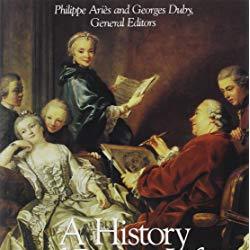
A History of Private Life, Volume III: Passions of the Renaissance, Edited by Roger Chartier, Series edited by Phillippe Ariès, Harvard University Press, 1993, ISBN 9780674400023
The life or ordinary people from the Renaissance to the Enlightenment, centered in Europe and especially France, you’ll read about the everyday lives of women and children, common men, education, marriage and well, the private life. This whole series (of 5 volumes) is worth each penny.
Themes: everyday life, history, women, Europe, France, children, education, Renaissance, Enlightenment, 16th century, 17th century, 18th century.
Available at: Amazon / Harvard University Press

A History of Private Life, Volume IV: From the Fires of Revolution to the Great War, Edited by Michelle Perrot, Series edited by Phillippe Ariès, Harvard University Press, 1993, ISBN 9780674400030
The first part is 18th century and deals with life pre, during and after French Revolution.
Themes: everyday life, history, women, Europe, France, children, education, Enlightenment, French Revolution, Victorian, Belle Epoque, WWI, 18th century, 19th century, 20th century.
Available at: Amazon / Harvard University Press

Black London: Life Before Emancipation, by Gretchen Gerzina, Rutgers University Press, 1995, ISBN-10: 0813522722
A glimpse into the lives of the thousands of Africans living in eighteenth century London.
Themes: everyday life, history, race, black, African, England, London, slavery, 18th century.
Available at: Amazon / You can also download it for FREE (ha! who needs Amazon now?)

Historia De La Vida Cotidiana En México 3: El siglo XVIII: entre la tradición y el cambio, by Pilar Gonzalbo Aizpuru, Fondo de Cultura Económica, 2012. ISBN-10: 9681677188
Common life in Mexico during the 18th century, from fashion, food and the markets, to the everyday life of mining cities, children and monks. This is book is a key reference for starting to read about the life of common people in the New Spain. Part of a series from the prehispanic times to the 20th century.
Themes: fashion, food, everyday life, New Spain, Mexico, Viceroyalty, The Americas, castas, mining, religion, catholicism, education, childhood, 18th century.
Available at: Amazon / Cambridge University Press / Fondo de Cultura Económica
FASHION

Auguste Racinet. The Costume History (Bibliotheca Universalis), Françoise Tétart-Vittu, Taschen, 2019, ISBN-10: 3836555409
I wanted to describe my undying love for this book, but I’m just gonna copy Taschen’s description: “Racinet’s Costume History is a landmark in the study of clothing and fashion. This reprint presents Racinet’s exquisitely precise color illustrations, as well as his delightful descriptions and witty commentary. From Eskimo attire to high French couture, this is an unrivalled encyclopedia for students, designers, artists, illustrators, and historians, and anyone interested in style.” So, yeah, this 19th century book rules.
Themes: fashion, interior design, furniture, 18th century, 19th century, fashion history, ancient times, middle ages, renaissance, baroque, rococo, victorian, menswear, womenswear.
Available at: Amazon / Taschen

Costume in Detail: 1730-1930, Nancy Bradfield, Quite Specific Media Group Ltd, 1999, ISBN-10: 0896762173
Focused on womenswear, Nancy Bradfield shares with all of us detailed illustrations and descriptions, as well as good information about fashion, garments, shapes, finishings, etc, of extant garments in private collections. A wonderful reference book for reproducing fashion and for illustrations or authors who want to give their character accurate fashion.
Themes: fashion,womenswear, extant garments, 18th century, 19th century, 20th century.
Available at: Amazon / Book Depository
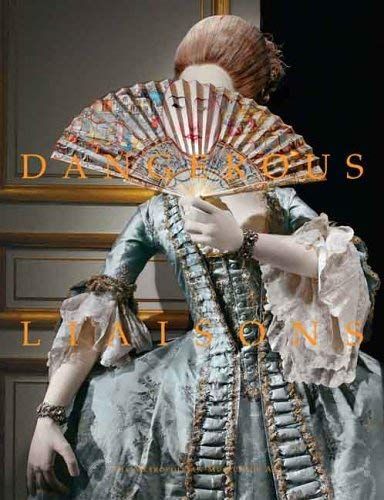
Dangerous Liaisons: Fashion and Furniture in the Eighteenth Century, by Harold Koda, Andrew Bolton, Mimi Hellman, Metropolitan Museum of Art 2006, ISBN-10: 0300107145
The book from a long gone exhibition at the Met Museum, it has extant clothes, good info, and the links between fashion and furniture design that make us perceive both as purely 18th century.
Themes: fashion, interior design, furniture, museum collections, extant garments, exhibition, 18th century.
Available at: Amazon / Metropolitan Museum of Art

Fashion, A history from the 18th to the 20th century, by Akiko Fukai, Taschen 25th anniversary edition, 2007.
A basic fashion history book starting in the 18th century from the amazing collection of the Kyoto Costume Institute.
Themes: fashion, womenswear, menswear, embroidery, accessories, museum collection, extant garments, England, France, Europe, undergarments, 18th century, 19th century, 20th century.
Available at: Amazon in 1 volume and 2 volumes set.

Gallery of Late-Seventeenth-Century Costume: 100 Engravings, Caspar Luyken, Dover Publications, 2003, ISBN-10: 0486429865
Reprint of a collection of plates by Dutch engraver Caspar Luyken published in 1694. It shows men and women of different social classes and occupations. A key reference when looking for 17th century contemporary source material.
Themes: fashion, menswear, womenswear, Dutch, engraving, plates, 17th century, baroque, late 17th century, contemporary source.
Available at: Amazon / Dover Books

Historic Costumes and How to Make Them (Dover Fashion and Costumes), by Mary Fernald and Eileen Shenton, Dover Publications, 2006, ISBN-10: 0486449068
From the Middle Ages to the 19th century fashion, this book is a nice resource for theatrical costuming and has good but basic bits of historical fashion information. I recommend not to buy with no previous patternmaking and fashion background, since the diagrams are quite vague, and the descriptions even more. I personally only have used this book for reference of Medieval and early Renaissance fashion (which to be fair, are quite simple). Also, it is centered in English fashions.
Themes: fashion, theatre, menswear, womenswear, middle ages, renaissance, tudors, elizabethan, georgian, victorian, 15th century, 16th century, 17th century, 18th century, 19th century.
Available at: Amazon / Barnes and Noble / Dover Publications / Waterstones

How to Read a Dress, A Guide to Changing Fashion from the 16th to the 20th Century, Lydia Edwards, Bloomsbury Academic, 2017, ISBN-10: 1472533275
This books is very pretty and rather basic, it could be a really nice starting point for anyone getting an interest in fashion history. I’ve read reviews that it is “insultingly basic” which I do not get, I mean, if you cannot explain something in such a basic way that a child can get it, then you do not really master that subject. This books has pretty interesting info and it is a walkthrough of key silhouettes and extant garments, so it is not deeply detailed nor shows each and every silhouette of every decade of every century.
Themes: fashion, womenswear, gown, dresses, extant garments, museums, Europe, 16th century, 17th century, 18th century, 19th century, 20th century.
Available at: Amazon / Bloomsbury

Men's Garments 1830-1900: A Guide to Pattern Cutting and Tailoring, R. I. Davis and William-Alan Landes, Players Press, 1996, ISBN-10: 0887346480
A whole book only for menswear starting with the Regency silhouette and its very particular form until the turn of the 20th century. Yes. It is pretty good, I have to say, for all our Victorian outfit needs for the gentleman. I recommend this book (and the 2nd one on 19th and 20th centuries) for people with some knowledge of construction, grading, fitting, patternmaking, and tailoring, since it does not offer much sewing advice.
Themes: fashion, menswear, accessories, patternmaking, plates, 19th century, 20th century.
Available at: Amazon / Waterstones
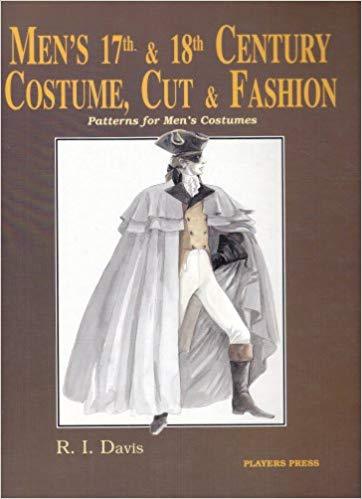
Men's Seventeenth & Eighteenth Century Costume: Cut and Fashion, R. I. Davis and William-Alan Landes, Players Press, 2000, ISBN-10: 0887346375
My personal love for menswear is fueled by this book that details the suits, coats and tailcoats from the 17th and 18th centuries. It includes military fashion and other everyday clothes like breeches, capes, waistcoats, etc. via plates, figures, diagrams and texts. I recommend this book (and the 1st one on 19th and 20th centuries) for people with some knowledge of construction, grading, fitting, patternmaking, and tailoring, since it does not offer much sewing advice.
Themes: fashion, menswear, accessories, patternmaking, plates, 17th century, 18th century.
Available at: Amazon / Book Depository
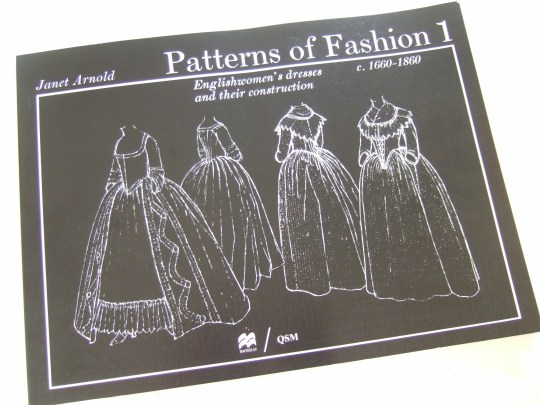
Patterns of Fashion 1: Englishwomen's Dresses and Their Construction C. 1660-1860, by Janet Arnold, Drama Publishers, 2005, ISBN-10: 9780896760264
THE key source of patterns of extant garments, this series of books are the result of constant research on garments from museums, with details and info on construction, history and fashion details. You know, the kind of information you could only get with those garments in your hands.
So, as a resume, in this list there’s only the books with 18th century info in them, BUT you should actually have ALL of the Patterns of Fashion books.
Themes: fashion, womenswear, England, extant garments, museums, Europe, patternmaking, 17th century, 18th century, 19th century.
Available at: Amazon
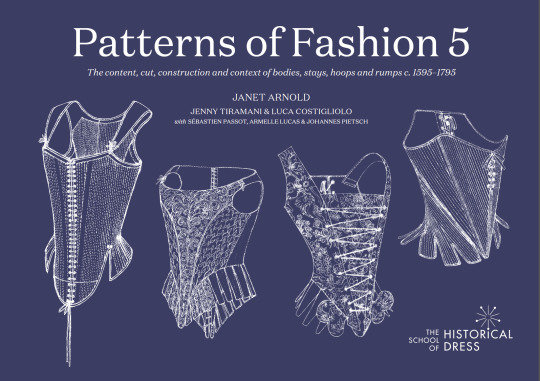
Patterns of Fashion 5: the content, cut, construction & contexto of bodies, stays, hoops & rumps, c 1595-1795, by Janet Arnold, Jenny Tiramani, Luca Costigliolo, Sebastien Passot, Armelle Lucas and Johannes Pietsch, The School of Historical Dress, 2019
The new book from the series is about undergarments from the 16th to the 18th century. It is only available through the store of the School of Historical Dress. Probably the best spent £35.
Themes: fashion, undergarments, stays, womenswear, England, extant garments, museums, Europe, patternmaking, 16th century, 17th century, 18th century.
Available at: The School of Historical Dress
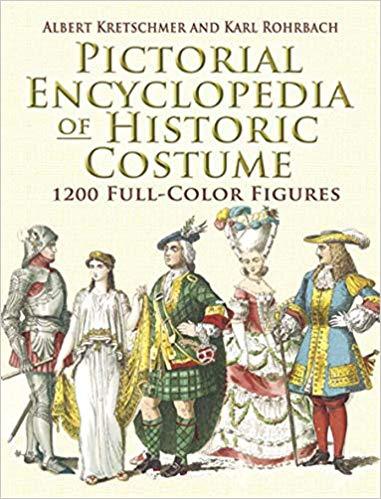
Pictorial Encyclopedia of Historic Costume: 1200 Full-Color Figures, Karl Rohrbach (Author), Albert Kretschmer (Compiler), Dover Fashion and Costumes, 2007, ISBN-10: 0486461424
A reprint of Die Trachten Der Völker from 1906, this book, this is a great great encyclopedic work of fashion history, from ancient Egypt to late 19th century. It includes clothes for people of different social backgrounds, accessories, jewels, shoes, etc. I think that for the fashion history lover, the Rohrbach+Racinet combo is a must.
Themes: fashion, interior design, furniture, 18th century, 19th century, fashion history, ancient times, middle ages, renaissance, baroque, rococo, victorian, menswear, womenswear.
Available at: Amazon / Dover Publications
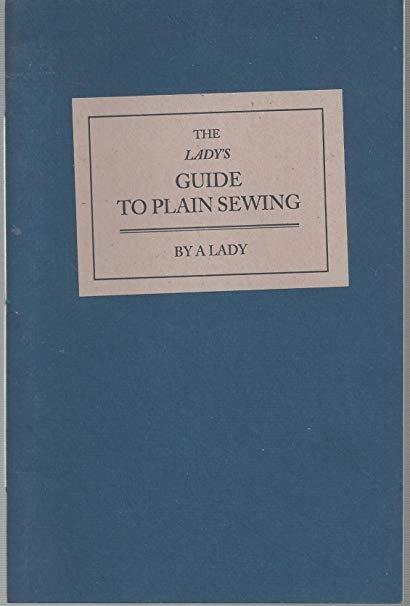
The Lady's Guide to Plain Sewing, Book I, Kathleen Kannik, ISBN 10: 0-9640161-0-9
References and tips for plain hand sewing, a key reference to achieve basic stitches that are historically accurate. It includes basic construction of items and some decorative techniques. Many of these techniques are still used in couture. This book is part 1 of a set of 4.
Themes: fashion, undergarments, womenswear, menswear, sewing, stitches, techniques, how to, patternmaking, 17th century, 18th century, 19th century, 20th century, couture.
Available at: Kannik’s Korner / Amazon (kindle edition) / Amazon
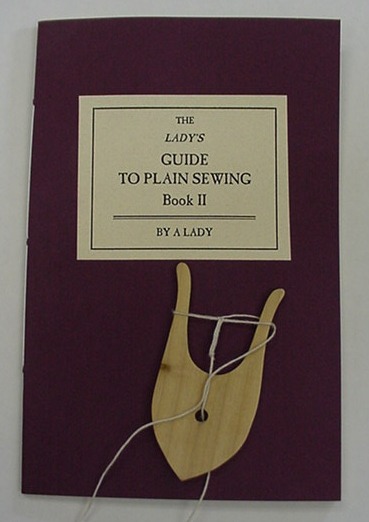
The Lady's Guide to Plain Sewing, Book II, Kathleen Kannik, ISBN 0-9640161-2-5
More sewing stuff with additional stitches and seam techniques, gather attachments, button making, gussets, re-enforcements, cord making, and an 18th century alphabet for cross stitching. This book is part 2 of a set of 4.
Themes: fashion, undergarments, womenswear, menswear, sewing, stitches, techniques, how to, patternmaking, 17th century, 18th century, 19th century, couture.
Available at: Kannik’s Korner / Amazon
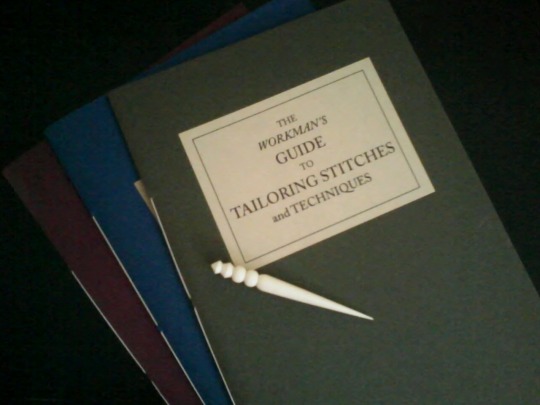
The Workman's Guide to Tailoring Stitches and Techniques, Kathleen Kannik, ISBN 0-9640161-4-1
Now it’s time for historical tailoring stitches and techniques. This book is part 3 of a set of 4.
Themes: fashion, tailoring, menswear, sewing, stitches, techniques, how to, patternmaking, 17th century, 18th century, 19th century.
Available at: Kannik’s Korner / Amazon

The Lady's Economical Assistant or, The Art of Cutting Out, and Making, The most useful Articles of Wearing Apparel, Without waste; Explained by the Clearest directions, and Numerous Engravings, of Appropriate and Tasteful Patterns, ISBN 0-9640161-3-3
A re-drawn publication of a 1808 book, with cutting directions and patterns for infant clothes, girls, boys, some for men and women, and linens. Many illustrations and a supplement. This book is part 4 of a set of 4.
Themes: fashion, undergarments, kidswear, children, babies, infants, womenswear, menswear, sewing, stitches, techniques, how to, patternmaking, 17th century, 18th century, 19th century.
Available at: Kannik’s Korner / Amazon

The American Duchess Guide to 18th Century Dressmaking: How to Hand Sew Georgian Gowns and Wear Them With Style, by Lauren Stowell and Abby Cox, Page Street Publishing, 2017, ISBN-10: 1624144535
This book is such a good starting point for a 18th century wardrobe, since it walks you through the key outfits of the century in a simple and clear way. I think a background in patternmaking is a plus, especially for the most complex projects, but the basics are easy to follow.
Themes: fashion, patternmaking, how to, womenswear, 18th century.
Available at: Amazon / American Duchess
BEAUTY

18th Century Hair & Wig Styling: History & Step-by-Step Techniques, Kendra Van Cleave, Nice One, ISBN-10: 0692220437
Kendra van Cleave have been everyone’s guide into the 18th century beauty and hair (and of course, costuming) for quite a long time, thanks to her blog, Démodé, and now she published this well researched book with easy to follow instructions for all kinds of 18th century hairstyles. So, go get your wig and get to work. Also, at the book’s website there some videos, and at her blog you can find even more resources, tutorials, etc.
Themes: fashion, beauty, hair, wigs, 18th century, how to.
Available at: Amazon / 18th Century Hair Website
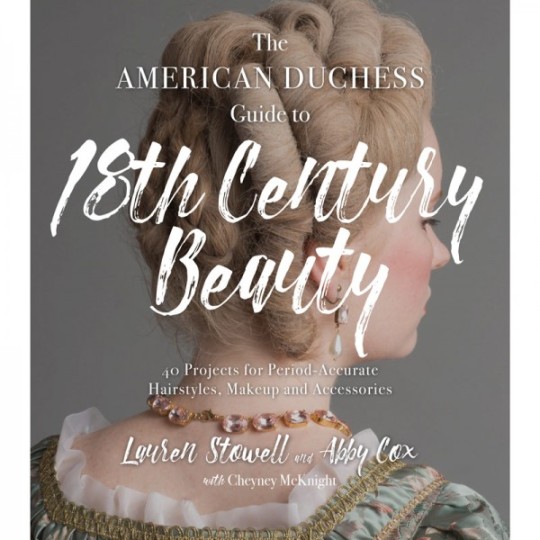
The American Duchess Guide to 18th Century Beauty: 40 Projects for Period-Accurate Hairstyles, Makeup and Accessories, by Lauren Stowell and Abby Cox, Page Street Publishing, 2019, ISBN-10: 1624147860
I KNOW this is not available yet, but I think it will be at least as good as the fashion one. Already on my pre-order list, it will be available on July 9th.
Themes: hair, hairstyles, hair and makeup, makeup, accessories, how to, womenswear, 18th century. Available at: Amazon / American Duchess
#sometimes I write stuff#books#my 18th century library#or something#18th century#fashion#history#beauty
629 notes
·
View notes
Text
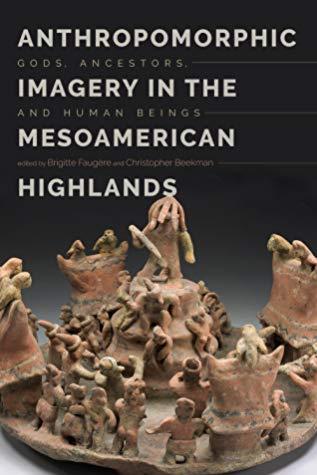
Anthropomorphic Imagery in the Mesoamerican Highlands: Gods, Ancestors, and Human Beings
edited by Brigitte Faugère & Christopher Beekman
---
In Anthropomorphic Imagery in the Mesoamerican Highlands, Latin American, North American, and European researchers explore the meanings and functions of two- and three-dimensional human representations in the Precolumbian communities of the Mexican highlands. Reading these anthropomorphic representations from an ontological perspective, the contributors demonstrate the rich potential of anthropomorphic imagery to elucidate personhood, conceptions of the body, and the relationship of human beings to other entities, nature, and the cosmos.
Using case studies covering a broad span of highlands prehistory—Classic Teotihuacan divine iconography, ceramic figures in Late Formative West Mexico, Epiclassic Puebla-Tlaxcala costumed figurines, earth sculptures in Prehispanic Oaxaca, Early Postclassic Tula symbolic burials, Late Postclassic representations of Aztec Kings, and more—contributors examine both Mesoamerican representations of the body in changing social, political, and economic conditions and the multivalent emic meanings of these representations. They explore the technology of artifact production, the body’s place in social structures and rituals, the language of the body as expressed in postures and gestures, hybrid and transformative combinations of human and animal bodies, bodily representations of social categories, body modification, and the significance of portable and fixed representations.
Anthropomorphic Imagery in the Mesoamerican Highlands provides a wide range of insights into Mesoamerican concepts of personhood and identity, the constitution of the human body, and human relationships with gods and ancestors. It will be of great value to students and scholars of the archaeology and art history of Mexico.
---
Contributors: Claire Billard, Danièle Dehouve, Cynthia Kristan-Graham, Melissa Logan, Sylvie Peperstraete, Patricia Plunket, Mari Carmen Serra Puche, Juliette Testard, Andrew Turner, Gabriela Uruñuela, Marcus Winter
Brigitte Faugère is professor at the Université de Paris I Panthéon-Sorbonne. An archaeologist specializing in the north-central and western parts of Mexico, she is the director of an excavation project on the Preclassic Chupícuaro in the Lerma Valley and author of Entre Zacapu y Río Lerma: Culturas en una zona fronteriza, Las representaciones rupestres del centro-norte de Michoacán, and Cueva de los Portales: Un sitio arcaico de Michoacán, México.
Christopher Beekman is associate professor of anthropology at the University of Colorado Denver. His research focuses on sociopolitical organization in ancient western Mexico. He has directed excavation projects at Llano Grande and Navajas and surveys in the La Primavera region and the Magdalena Valley. He is a coauthor of the first volume of the Historia de Jalisco and has coedited several books, including Shaft Tombs and Figures in West Mexican Society.
---
Order now and use promo code FAUG19 to get 40% off! - http://campaign.r20.constantcontact.com/render?m=1102467236383&ca=08187121-2da9-4419-9a8c-efe9a378e881
University Press of Colorado page - https://upcolorado.com/university-press-of-colorado/item/3733-anthropomorphic-imagery-in-the-mesoamerican-highlands
#archaeology#arqueologia#mesoamerica#mexico#art#arte#history#historia#books#reading#west mexico#aztec#puebla#tlaxcala#Teotihuacan
29 notes
·
View notes
Text
HERE SHE IS !!!
(((o(*゚▽゚*)o)))



Finally I get to show her in the blog ! 😄😄👏🏻👏🏻
Her name is Victoria and she's an energetic, positive, kind of tsundere, intelligent girl. She met Sasuke in the university. She was an exchange student, when Sasuke was waiting for the wormhole, Victoria was looking for him since he forgot his apartment keys at the classroom, but when she finally reached him a thunder was the last thing they saw before arriving to the Sengoku Era.
The reason I draw her with her prehispanic clothes is because I wanted to show her traditions and roots. The difference of her culture and the Japanese.
I think that's all I have for now ! Just wanted to have her introduced in my blog 🌟🌟✨👏🏻👏🏻✨✨👌👌💖💖
32 notes
·
View notes
Text
Binni Záa, Cap. 4 Pitao Copycha y Cocijo
youtube
#youtube#méxico#mexico#binni záa#binni zaa#zapotecos#zapoteca#zapotec#universos prehispanicos#universos prehispánicos#prehispanic universe
0 notes
Text
References to Mexican Culture in Coco
By now, you’ve probably heard Coco is one of the most well researched films about Mexico and its culture. There are many small details that make it feel like Mexico: the stone roads in a small town, the traditional embroidery patterns in the shirts of Miguel’s female relatives, an uncle wearing a soccer team shirt, even a bowl of limes in a stand of aguas frescas. Of course, the looks of papel picado, day of the dead altars, and cemeteries are also well represented. The clothes of the relatives Miguel sees in the world of the dead is accurate to their eras. While these are a nice touch, you’re ultimately not missing out on anything by not spotting them, so in this post I wanted to talk about the more culturally based details that show the most research and you might not understand if you’re not very well acquainted with Mexican culture:
Names and pronouns
1. Coco
This one is the most straightforward, so let’s start with the name of the movie. While the protagonist is called Miguel, we soon learn that Coco is his great grandmother. “Coco” is what we call a woman called “Socorro” (lit. “help” - it’s a very traditional name that’s considered old fashioned).
The Rivera family calls her “Mamá Coco,” which means “Mother Coco.” They also call Imelda “Mamá Imelda,” and so on. Calling your grandparents “mamá” or “papá” instead of “abuelita” and “abuelito” is a thing you can do, though I can’t say how common it is.
In the Spanish version of the film, Miguel’s grandmother, Elena, talks to Mamá Coco with “usted” (I didn’t notice other instances, but they might be there). Spanish has a formal and an informal version of singular “you:” “usted” for formal, “tú” for informal. The verb conjugation also changes depending on which one you use. It is used differently all through the Spanish speaking world, but in Mexico, other than older people you respect (like a teacher), you can talk to older family members with “usted,” which means respect rather than the distance the formality might imply. Nowadays, it has fallen out of use: as someone born in the 90s, my grandparents talked to their parents almost exclusively with “usted;” out of my parents, my mother talked to hers with “usted” and my father with “tú;” I speak to my parents with “tú.” I have cousins on my mother’s side that talk to their parents with “usted,” but I would say that makes them a minority nowadays.
Traditions and beliefs
2. Crossing to the world of the dead on a bridge of marigolds
If you paid very close attention, you might have noticed two children scattering marigold petals on the ground and their mother telling them not to scatter them, but to make a bridge so the dead could cross over. It was easy to miss, but that’s actually something we believe!
There are several types of flowers you can place in a day of the dead altar, but the one you can’t do without is the yellow marigold. Its petals are scattered all around the altar, and at the very front, you’ll form a path surrounded with candles. The bright yellow will help the dead properly make their way to the altar, and the candles surrounding the path will light their way.

3. Crossing to the world of the dead with a xoloitzcuintli
Several prehispanic cultures had a similar concept of the underworld as many other cultures around the world, in which there was a river they had to cross to get there. For both the Aztecs/Mexicas and the Mayas, a xoloitzcuintli would guide their souls so they could cross the river safely and arrive to Mictlan (Mexicas) or Xibalba (Mayas). To achieve this, a xoloitzcuintli would be sacrificed and buried with its owner. Day of the dead altars can have a xoloitzcuintli figure so that the dead can make it back safely as well.

4. Being thrown into a cenote
My screenshot isn’t the best but at some point, Miguel is thrown into a big pit with water. That’s not just any random pit, but a cenote.
Cenotes are naturally ocurring sinkholes caused by the collapse of limestone. The word “cenote” has Maya etymology, as cenotes are commonly found in the Yucatán peninsula, where they (still!) live. In old times, they would sacrifice animals and people as tributes to the gods, and also throw ceramic objects and jewelry as part of the tribute.

5. Alebrijes
I left these for last because they don’t have any deep meaning. Alebrijes are colorful fantastic animals that a man called Pedro Linares saw in a fever dream. He was a skilled artisan, so when he woke up from his long sickness, he brought them to life in his art.
In Coco, alebrijes are spiritual guides, and while their designs are to the likes of the real alebrijes, the film actually gave them a more important role than they have for us.
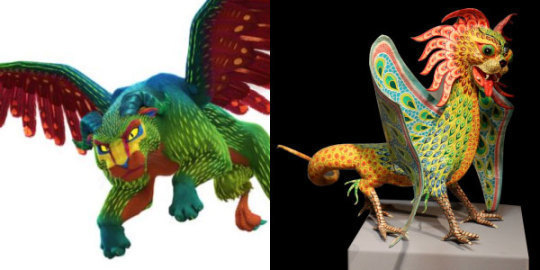
Music
6. Genres of Mexican music
The songs in Coco all belong to genres we’ve grown up with, so even if someone isn’t that knowledgeable in music theory or genres, we could vaguely tell they sounded “Mexican” (some more than others). Someone who is more knowledgeable of music genres can help me out here, but I think:
- Remember Me / Recuérdame is a bolero ranchero.
- Much Needed Advice / Dueto a través del tiempo is a ranchera.
- Everyone Knows Juanita / Juanita is a corrido.
- Un Poco Loco is a son jarocho.
- The World Es Mi Familia / El mundo es mi familia is huapango inspired.
- Proud Corazón / El latido de mi corazón is a a son (son de mariachi? I’m most uncertain about this one).
6.5 Un Poco Loco
Un Poco Loco starts in English as
What color is the sky, ay mi amor, ay mi amor, You tell me that it’s red, ay mi amor, ay mi amor
And in Spanish as
Que el cielo no es azul, ay mi amor, ay mi amor, Es rojo dices tú, ay mi amor, ay mi amor
(You say the sky isn’t blue, oh my love, oh my love, It’s red, you say, oh my love, oh my love)
This might be a deliberate reference to a huapango called “Cielo rojo,” which says:
Mientras yo estoy dormido Sueño que vamos los dos muy juntos A un cielo azul Pero cuando despierto El cielo es rojo, me faltas tú
(As I sleep I dream of us close together Going towards a blue sky But when I wake up The sky red, I am missing you)
Within the universe of the movie, this would make it an anachronistic reference, though. Additionally, Cielo rojo is a song of loss and Un poco loco is about a woman who thinks very differently and likes to say everything backwards, and that makes him crazy (in a good way!). Hence, in English we’ve got her saying to put his shoes on his head instead of his feet, and in Spanish him saying she might think with her feet and also how she keeps playing with his thoughts. Cielo rojo is a pretty sad song.
7. La Llorona
And I purposefully left La Llorona out of that list (it’s originally a son istmeño, though).
There’s a full musical number in Spanish, which seems to have suprised some people. For those of us who watched Coco in Spanish, it wasn’t too hard to guess it was this one: La Llorona was likely left in Spanish because it’s a very old folk song, one of those that are so old it has no known author and there are many different versions of the lyrics.
“Llorona” just means “weeper,” which is not really as unusual of a word in Spanish as it is in English. It’s closer to “crybaby” in use. She’s also what we call a character in a Mexican folktale. If you’re curious, the version used in Coco says the following, with “llorona” being the singer herself:
Poor me, llorona, llorona dressed in sky blue Even if it costs me my life, llorona, I won’t stop loving you I climbed the highest pine tree to see if I could spot you Since the pine tree was so green, llorona, it cried upon seeing me cry
What is grief and what is not grief, llorona: it all is grief to me Yesterday, I was crying to see you, llorona; today, I’m crying because I saw you
Poor me, llorona, llorona dressed in sky blue Even if it costs me my life, llorona, I won’t stop loving you
Famous people
8. Ernesto de la Cruz
“Isn’t he an original charact-” NO LISTEN STAY WITH ME.
Remember how I said Remember Me is a bolero ranchero? Guess who we associate boleros rancheros with?

That would be Pedro Infante, who happens to have a strong resemblance to no other than Ernesto de la Cruz.
It’s probably not a coincidence at all, as later on we see Ernesto with Pedro Infante and Jorge Negrete at his party. Ernesto de la Cruz was explicitly stated to be inspired on both of them and another singer of the same genres, Vicente Fernández.
My parents left the movie saying “Pedro Infante didn’t deserve that burn,” lol.
9. Frida Kahlo (and Diego)
She does have a rather prominent role so she’s hard to miss. For those unaware, Frida is the artist who made the flaming papaya.
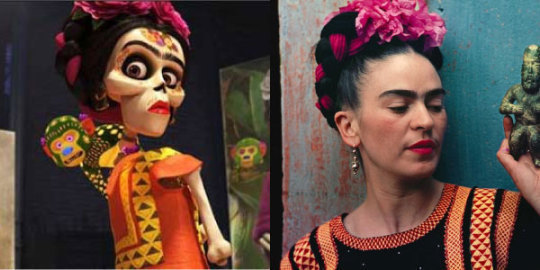
The themes in Frida’s are autobiographical, as she had a rather unusual life due to polio and injury. She painted herself and her suffering a lot. That might be why we get performances with many Fridas and things like a crying cactus that’s herself.
Bonus: her husband, Diego Rivera, is also in the same studio where we meet Frida. He was an important artist, specifically a muralist.

10. Other Mexican celebrities
I already brought up Pedro Infante and Jorge Negrete as characters that appear right beside Ernesto de la Cruz.
But we also get to see a cameo of many other famous Mexican names in Ernesto’s studio! Excluding the people at the piano, from left to right:
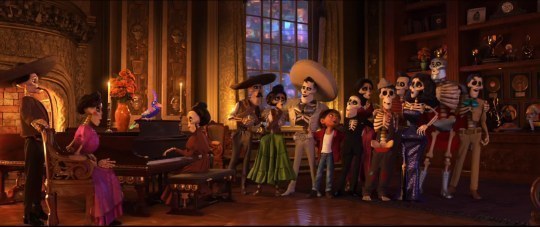
Emiliano Zapata, a revolutionary; (my best guess is) Adela Velarde, another revolutionary; Ernesto and Miguel; (probably) Agustín Lara, composer and singer; (probably) Dolores del Río, actress (in Hollywood too!); Cantinflas, comedian and actor; Pedro Infante, singer and actor; María Félix, actress; El Santo, wrestler and actor; Jorge Negrete, singer and actor.
They kind of looked like this:

Another bonus: this gal looks like the calavera garbancera / the Catrina illustrated by José Guadalupe Posada.
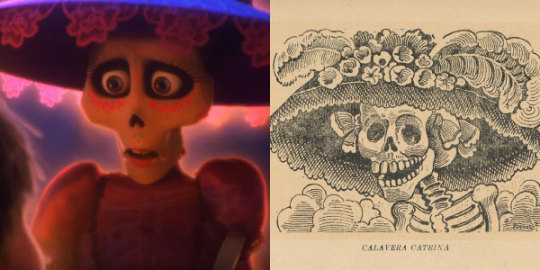
There might be more things I’m missing or forgot; if that’s the case, feel free to let me know! You can also fix my music genres for me since that’s never been my forte.
I hope this was of interest to someone!
17K notes
·
View notes
Text
Love all this headcanons, if you don’t mind I wanna share some headcanons of Mexico in the Chainsawman universe (because I have nowhere else to share these :( ) and a bit of that fused with yours.
So first if we take into consideration how the deals with devils work and prehispanic history, more specifically religion (and how it was practiced like in the case of the Mexicas where the main god was the God of War to which they often made sacrifices), there can be a bit of an implication that before spaniards came to Mexico, making contracts with devils would be a constant practice (of the priests) in those civilizations. Instead of fearing the devils, here they were worshipped. Mesoamerican gods tend to represente natural disasters rather than specific ideas or concepts like in the greek and roma pantheon, so it already seems reasonable.
Also in Mexico there’s a lot of superstition even nowadays so combined with the previous point I like to think that the practice of making contracts with devils is something that’s somewhat common (kind of like an open secret (no conozco la traduccion exacta de secreto a voces)) to the point everybody has a vague idea on how to do it or what the hell everybody knows at least one person that has made a contract (even if it’s for silly reasons with a weak devil).
All of this is my way of presenting another headcanon of why the Mexican public safety people ignore the calls that are made about the one armed foreigner that lives with 3 devils:
They’re more busy dealing with the constant presence of devils and independent devil contractors.
The natural disaster devils always come back either by their own will or because someone made a contract with one (like every year there’s a flood, a hurricane or two and like at least a couple earthquakes IRL).
A lot of gangs and/or crime organizations have people with contracts.
The curse devil is very common contract to the point someone goes like “oh yeah my cousin has a couple of nails for curses and stuff” (like seriously there’s cases of people finding odd stuff like bones, dolls, hair, ashes and the like at cemeterys and/or their houses because it’s part of rituals to curse a person IRL).
Someone calls to complain about Power causing trouble for the Nth time and it goes somewhat like this:
“Necesitamos ayuda hay un demonio causando destrozos en X“ [We need help there’s a devil wrecking stuff in X]
“Dejame adivinar: cuernos, actitud mandona, le gusta ir pateando cosas y a todo el que se le atraviesa?“ [Let me guess: horns, bossy attitude and likes to kick anything and anyone that crosses its path?]
“Ehmm si?“ [Umm yes?]
“*suspiro* ok mandaremos a alguien en cuanto podamos para lidiar con su demonio cabra o lo que sea“ [*sigh* ok, we’ll send someone as soon as possible to deal with the goat devil or whatever]
“¿Demonio cabra? pero si ni siquiera--“ [Goat devil? but it doesn’t even--]
“Si, si ya sabemos pero todos estan ocupa--“ [Yeah, yeah we know but everyone’s bus--]
“PERO-“ [BUT-]
“¡Chingada madre! ¡YA SABEMOS! pero tenemos problemas con el demonio de la inundacion ahogando gente y pandillas con clavos malditos. ¡DEJEN DE JODER CON LO DE LA CABRA!“ [Godamn it! WE KNOW! but we have problems with the flood devil drowning people and gangs with cursed nails. STOP CALLING ABOUT THE FUCKING GOAT!]
The public safety people receive calls weekly at the start but when the citizens start getting used to Aki, Denji and Power the frequency of the calls goes down until the only people that make calls are outsiders that are visitng relatives in town or just passing by.
Moving on with the last things I could think of. On autumn someone shares with Denji some pan de muerto (probably from making altars as an activity in school maybe) and he brings back home some of it, he brings it out and tells them what it is.
Power is impressed that there’s people that would turn dead people into bread, after she says that Denji tells her they do that to pass on knowledge and power to other people and that’s the reason why it’s more expensive than regular “pan dulce” as a joke. (pastries?? idk what the translation for that is)(Also idk if everywhere in the country it’s more expensive but where I live it’s a lot more expensive than just regular pan dulce)
Power believes it. She doesn’t even ask questions, because it makes sense after all, consuming another person should give you their power and knowledge right? Thus she becomes a fan of it and no one bothers to correct her.
Once day when she’s bored she asks Denji more about the place they’re in and why it’s so different from Japan and stuff like that, he eventually tells her about you know pre hispanic stuff and how things where waaaaayy back according to the history books and she’s somewhat interested in that, being the blood devil/fiend and all that.
She wants to go see ruins and places because she wants to see the places where she can be seen and worshipped in all her glory. When she’s there she goes around claiming to be a goddess and starts demanding sacrifices lol
She ends up being jealous of Angel because he has temples and shrines “made to honor him” (all the churches and cathedrals depicting angels of course) everywhere they go and tries to make him give some of them to her.
I always rolled my eyes whenever that post about too much fics always being setted up in American cities and not being afraid of use your own country because of how dumb it sounds.
Except...except until I watched Chainsaw man because...BECAUSE I CAN CLEARLY PICTURE DENJI WEARING ONE OF THOSE PUBLIC MEXICAN SCHOOL UNIFORMS
Just imagine it
Fleeing from Makima the Hayakawa family have to go somewhere far, somewhere Makima control won't reach them. Somewhere she will never thought to look after them.
México is perfect.
(In fact most latino countries are)
Because Aki uses most of his money to pay the costs of moving and buying fake IDs and also because they have to lay low they move to your common popular low income Mexican neighbourhood.
Denji enrolls in the local public high school
(Originally i was envisioning Denji in one of those public middle school uniforms, if you are Mexican you know which ones, but these work too)
Despite everything he does okay-ish in school.
He isn't the only teen who can barely read in high school and because he is a foreigner he gets a pass. Aki, armed with a dictionary, helps him with his homework as much as he can so yeah. He's doing ok.
Except when he's picking fights(the other boys are jealous of how much he is getting the girls attention) and/or being rude to teachers.
That's when they decide to call his parents for a much needed meeting.
What they weren't expecting was for a polite good looking young man missing an arm coming in and declaring himself Denjis older brother and guardian.
What they werent expecting much less was for said good looking young man to apologize profusely for Denjis behaviour and swear he will do his best to have a talk with Denji. That they will accept any punishment they deem necessary.
They love him immediately
They love him a little less(not by much really) once they learn what he does for a living.
Because they needed to make a lot of money quick (in case they had to run away again) and without being questioned about their papers, past or appearance Aki has no choice but to open the most prolifilic bussines you can open in Mexico starting from nothing:
He starts a puesto de micheladas.
(of course Aki has the skills to do something else but even if he manages to not doubt the quality of his forged papers he is still a clearly japanese immigrant with a dubious past and a missing arm who barely speaks the language. He has no chance at formal jobs and said missing arm disqualifies him for most manual labor. The easiest route is food and still he has problems by not being familiar with the cuisine and ingredients)
It becomes popular among young people because Power works there attending customers and everyone wants to bang Denjis super hot sister so they buy more and invite her over
Aki of course doesn't let Power drink but she doesn't know because he always prepares super special drinks for her(nothing more than a simple flavored soda) made to look the same ( yes for those who know un simple refresco preparado. He got the idea from watching customers come in with their kids and asking for that) and she keeps boasting about how mighty she is by not getting drunk like the other weak humans with their feeble minds even though she gets special drinks.
All the customers know what Aki does but nobody dares to speak up against the young man with a missing arm and the stare of someone who has seen too much and seems capable of anything... So they accept it as part of her charm.
That and how easily she burns her tongue with anything remotely spicy noy matter how much she denies it (Denji isn't much better but he manages. If he can eat rotten food he can handle a little spicy here and there)
Denji also works there attending customers and breaking fights. An amazing feat considering how tiny he looks even after throwing out 5 rowdy customers.
Between that, Power being unable to keep her caps/hats on while working (there's just so many times you can convince people that her horns were just a drunk mass hallucination) and the rumours of Denji just standing up and dusting his pants after getting shot in the chest after he resisted when someone tried to rob him on his way back home from school people quicky realize the new neighbors are demons/fiends.
But either because the mexican equivalent of Public Safety doesn't exist or they are just incompetent a hunter never comes no matter how many times they call.
At most the police comes when it gets too loud but all Aki has to do is offer free drinks to the officers and they go on their merry way.
So once people realize they aren't there to drag their souls down to hell and are mostly harmless (yeah they seem super strong and could kill them... but so could many other things. Fear of the death? Here? Pfffft) they leave them alone. They couldn't be worse than the santeros from the other street.
Mostly alone.
Aki still gets stinky eyes from the women whenever he goes to the market to buy groceries
That all changes once Angel goes out.
After seeing nothing happens and nobody came after them once their devil nature got too hard to hide they thought people were ok with them being devils.
So Angel, who was absolutely bored out of his mind from being cupped inside the house all the time as the most outstanding of them, argued that if Power could go out so could he. There was no way he could do worse than Power.
So after a lot of begging Aki finally relented.
It was a grave mistake.
Not because people were scared of Angel.
Oh no.
On the contrary.
All the grandma's in the neighbourhood fell in love with him.
They thought he was a straight up actual angel that descended from heaven to bless the earth.
The concept of an angel devil was unthinkable. Who would in their sane mind fear angels?
Angel hates it.
He wants to be back locked inside the house but it's too late. The grandma's come everyday knocking at the door asking for Angels power to relieve their aches or bless their family.
Even the priest at the local church had to intervene and ask them to stop. That this was against god.
It was to not avail.
The old ladies were dead set on their beliefs. Adoring angel and putting him on a pedestal like a golden idol. Venerating him.
Even when time passed and the novelty wore off. When it was obvious Angel couldn't do/wouldn't do half of the shit they believed. Even then they kept loving him.
He was a fine looking polite young man. Very cute.
Actually he was pretty rude.
They still wouldn't stop pinching his cheeks and sending him back home with dish upon dish of food they cooked for him.
Unluckily for Angel Aki gladly accepted th and even encouraged Angel to keep doing whatever he was doing
After all this time he was still struggling to cook with ingredients he wasn't familiar with (why didn't the rice stick the way it should? Why did noodles taste different? WHAT THE FUCK WAS A MARUCHAN WITH CHILE PIQUIN Y LIMON??) and he was starting to worry about running low on money and Denjis and powers health with how much street food they had to ate to compensate Aki's lack of cooking skills.
This way at least Power and Denji got to eat some home cooked meal instead of stuffing their mouths with tacos de a $1 (Aki knew Power and Denji could eat almost anything and those tacos were a lifesaver those first months but yeah... Better to not risk it)
Besides now everybody was starting to treat Aki better whenever he went out (and this time without him having to give free drinks).
Because...
Those who had control over the local grandmas had control over the whole neighbourhood.
And Angel hated it.
He hated it even more when the priest came over and declared Angel had to help out at church to compensate for leading poor defenseless old ladies through the path of damnation.
Angel was going to refuse until Aki heard the priest was willing to pay him a wage.
It was the only job that would allow Angel to work without having to stuff himself in an overcoat to hide his wings in the middle of the day at 20°C. He would just look like a super devoted disguised weirdo Aki argued.
Angel didn't care.
It would be pretty devilish of Angel to pretend being an actual angel working in a church Aki tried.
Angel still didn't care.
Well in that case if Angel didn't want to work there then he could busy himself by working shifts at the business with them and watching over Power during serving hours so Denji could dedicate more time to his homework.
Angel immediately accepted the priest offer
His job mas mainly cleaning and organizing papers around.
Truth be told Angel sucked at his job and spent most of it sleeping but the grannies were once again attending church every sunday and that was worth the pay to the priest.
(Still Angel also ended up taking shifts to watch over Power and prep with Aki so Denji and power herself could free some time)
(Even though it wasn't that necessary bc Denjis single teachers kept asking denji about his hot older brother after the first time Aki went and were very lenient with him when he didn't turned in homework once they knew Denji tended to help Aki out)
Now that the community was treating them better and Denji had more time he took up little jobs at the market helping butchers cut down big frozen pieces of meat with his powers or carrying around ladies bags and heavy crates.
He usually got payed with money. But sometimes with a bag of fruit/vegetables to Aki's delight. Or sometimes even with a bag of blood from the butchers which was really helpful in case of a sudden injury or simply to quell Powers complains.
Now with both Angel's meager pay and Denji's extra money Aki was able to ample the business by adding hot wings and hamburgers (the tears he cried when he discovered he could at least do that) and stop feeling guilty about selling alcohol to young people.
The business ran smoothly and the four of them could mostly calm down.
Or that was until Christmas season came and the old ladies and the priest himself wouldn't stop asking Angel if he was going to be part of the pastorela this year.
They of course thought he was perfect to play the part of the angel.
Angel of course doesn't want to
Aki tells Angel that as part of the church staff it's his obligation to take part of this even (it really isn't but they don't know that) and that he could learn something
Angel tells Aki that in that case he should be really happy because they also want Power to play as one of the devils
Once Power hears about the piñata and the sweets she'll get nobody can change her mind.
She of course also ends up dragging Denji into it. He plays as one of the peasants trying to get to Bethlehem while Power is one of the mischievous devils trying to derail them and Angel as the reluctant angel that guides them
They are a little too old to be part of the play. It's ridiculous.
But now that all his family is part of the play Aki can worm his way into the group of moms preparing the meal for that day and he finally gets to learn how to cook local dishes.
The day of the play unhappy with the planned ending Power tries to wrestle the other kids for protagonism to show the mightiness of demons. Denji tries to stop her. Angel just watches from the sidelines.
Its complete chaos. Kids are screaming. The scenario is getting destroyed.
It's like any other pastorela.
Aki doesn't stop taking pictures like a proud dad during the whole ordeal.
Once it's time for the piñata Power goes hog wild and summoning a blood bat breaks it before anybody gets a chance to hit it.
She is pretty dissapointed when all that comes from it it's 'more veggies'.
All in all they enjoy it.
Now that Aki can finally cook he can finally leave the alcohol business (and stop corrupting the kids as he sees it on his mind) and goes a step forward:
He opens a puesto de comida económica
Angel quits his job at the church to help him full time.
Denji and Power help him after school when it's more crowded.
Power now also enrolls into school but although she's s little old she starts at middle school.
Aki and the others don't think she could handle highschool yet. They are correct.
And this marks the first year of the Hawakawas coming to live in Mexico.
Life is good.
Bonuses I came up with while talking about this au with my best friend:
At some point during the first months Aki buys *insert your adultered/cheap alcohol of preference* because he wants to cut up expenses and he hear someone say it does the job/every puesto de bebidas uses it.
Half of Denji class misses school the next day
The Mexican public safety department receives that day a lot of calls about three powerful demons cursing all the teens into the hospital in a certain neighbourhood. It's one of the first complaints about them they get.
Not wanting to deal with that shit they literally ignore it.
In their defense they also think it's another case of parents blaming their kids getting drunk/high on demons.
The fact they are kind right doesnt make it better
(am I talking about the parents? The Mexican public safety? Yes)
The reason why Mexico is the perfect place for the Hayakawa to hide it's because once they escape Makima/Japan public safety starts calling every devil containment dependence around the world asking for them and the Mexican branch very aware there are lots of reports of sightings of devils fitting the description but wanting to ignore it being like "no.... We haven't seen anything like that"
The reason why the Mexican department doesn't tell on them can be summarized by the 3 points:
They literally don't want to deal with this shit
Some of the officers know Aki and like the free micheladas he gives them so they ain't snitching on him (yes Aki manages to befriend the police here faster than he ever did back in public safety. They even invite him to smoke with them when they are drinking at his bussines. Aki can't really refuse.)
eventually the reports get lost among a bunch of other papers they had so at some point they aren't even lying anymore and that way get to evade Makimas control
So in the ends it's something like: Blood fiend? Chainsaw devil? We only know al chino y sus hermanos
they then proceed to hang up on Makima
Aki cries everytime he goes to the market. He doesn't understand why the lady at the marked keeps giving him a rock whenever he asks for something to help him clean the bathroom.
He's pretty sure the words are right. He asked Denji and he says his pronunciation is alright...SO WHY? WHY THE FUCl DOES THE LADY KEEP GIVING HIM A ROCK?
He now has 60 of them.
The boy just nods and smiles and pays for the rocks instead of asking. He stores them under the cupboard.
He's very stressed.
Between school and his amazing adapting skills Denji is the best of them at spanish. Aki has to carry a dictionary and hesitates when enunciating. Power just sputters nonsense and gets way with it. Angel just doesn't talk much.
He actually could be very good at it but he's too lazy to study it. Besides he only has to show the minimum of interest in something before an old lady is giving it to him for free. So as Power he gets away with not really practicing the language.
Denji and Power are the kind of kids to always buy unhealthy snacks (papitas con chile, chicharrones, dorilocos) after school even though they can barely handle spicyness.
Aki is suffering for their health. He doesn't understand why they do that when there's so much new fruit they can eat. Aki is in heaven everytime he buys himself un vaso de fruta picada or un agua de sabor.
Angel on his part is content with all the new desserts he gets to eat: Fresas con crema, plátanos fritos, duraznos en almíbar to name a few
Not to mention how crazy Angel goes after he learns bout all the new ice cream flavors there. And raspados and paletas congeladas.
That's all for now folks.
If I ever think of something more for this au I'll let you know and if you come with something else let me know.
I had so much fun writing this.
#Chainsawman#Mexico in Chainsawman#Headcanons#and/or fanfic material#The fact that the latin spanish dub is actually mexican sells the idea#these are all i could think of at the moment
80 notes
·
View notes
Text
Hellish Coup d'etat
In which Arawn comes across an unlikely ally with a proposal he can’t dismiss.
ARAWN
Once Mateo had fallen asleep Arawn had walked a little further down the path. He couldn’t abandon the boy, of course, as he would need him at the end, but for now he would leave the useless heap in his grave to peak ahead of what they would be facing.
The meadows seemed to stretch on for all eternity. This did not surprise him since there were many souls that lived their forever here, and so would any more. Neither here nor there, not good enough but not bad enough, they could live their death in a comfortable peace.
It was sickening to look at. All these souls settling for this. It was nonsense. He didn’t know how anyone could stomach not getting what they deserved for the rest of this realm’s existence, and he never would. Soon neither would they, he supposed, with what he had planned for them.
Arawn continued to walk, slow and steady, down the path, and soon felt that prickle of acknowledgement that someone was watching brush against his neck. He didn’t acknowledge it.
If whoever or whatever it was wanted something then they would just have to come and take it.
ORIZABA
“Yet another feisty duo wanders into the Underworld to see how we all suffer down here, hmm?” a feminine, musical voice rang in the man’s ears, as a chilling breath leaved what felt like an invisible pair of lips. “To think humans have begun to tire of their own world’s tourism. What’s the universe come to?”
A large moth took flight from somewhere in the meadow and hovered in front of Arawn, as if looking him in the eye. “Though perhaps your goal is another. One way or the other, you’ve been foolish enough to open a door you shouldn’t have unlocked.”
With that, an enormous flock of moths, identical to the other one, winged their way into view, flying in line to form some sort of moth cyclone not far away. A figure seemed to materialize from within as the winged critters dissipated into nothing.
“It’s nice to be back,” the figure said. It had now taken the form of a dark-skinned woman, seemingly in her 40s or so, with two enormous moth-like wings attached to her back, as well as a bright dress and matching accessories of purples and pinks. “I have you to thank for that.”
ARAWN
He blinked slowly at the sound of the voice, unimpressed with whatever act was going on. Arawn turned towards the sound of the voice, annoyingly vain, his upper lip curling in disgust at the effect of their voice being so close to his ear. It was not uncomfortable so much as it was angering, who dared to think they had permission to speak to him in such a way?
An eyebrow arched as a moth, his chin tipping upwards in defiance at its words.
“I am no fool,I knew exactly what I was doing when I opened those doors. t should never have been locked in the first place,” he argued. “Soon, they will be obsolete, and the divide between this plane and the one above will be meaningless.”
He watched on as the figure came into existence. Disgusting choice of physical animation, but, looking at the lack of string, he supposed creatures of the Underworld would not be described in sonnets and poetry.
“And who are you?” Arawn asked, a curious lit to his demeaning tone.
ORIZABA
“I am what you could only aspire to be, necromancer,” the moth fairy exclaimed, her wings actively flapping behind her as she spoke. From their tips, bits and pieces of obsidian stone seemed to constantly fly off due to the constant movement.
The woman took flight, and soared around the air. She moved down, and took a pair of laps around the man, barely touching him with her wings. “I suppose I should tell you my true name, as I expect us to be business partners in the very near future,” the woman called out, before landing in front of the man again, smiling at him with a tad of malice and pride. “Itzpapalotl is what the oldest civilizations call me. Of course, the name of the Warrior Goddess of the Night no longer holds any weight, because invaders filled with greed made sure to erase it from existence. You may also call me Orizaba. It’s a term of endearment, if you will.”
ARAWN
He did not move his line of sight from directly in front of him when the creature began to move around and around, like a child who could not sit still. It was amusing to listen to them speak, to hear the utter rubbish coming from their mouth. For a while. Then, as they came back into sight still talking, he was coming to the realization that they must love the sound their voice more than anything else.
“Business partners,” he repeated, humored. As if he would trust anyone else after what had happened with the Seal. That had only taught him that anything he needed done he would need to do himself. Even the simplest of tasks.
Arawn scoffed, scowling at the creature.
“Your credentials mean nothing.” He stepped forwards, tilting his head slightly as a smirk rose to his lips. “I would not ‘aspire,’ to be anything like you. I am the one who was able to move between worlds. I am the one who was able to break the bounds of our planes. And you? How long have you been rotting away down here? What makes you think that I would ever want to be in association with nothing but an overgrown pest?”
ORIZABA
“Yes, well, let’s just say some people decided to make sure I wasn’t able to come and go,” the moth fairy angrily said. “But that does not matter now, for you’ve set me free by making your way in here. If I’m still here it’s only because I wanted to thank you!”
The fairy once again took flight and took laps around. She returned eventually, and tilted her head. “Would you care to tell me your plans?” she inquired. “The problem with dark magic is that there’s always light magic out there to take care of it. I learned about that a long time ago. They will never let you use dark magic in peace even if you’re doing it for the good of the world.”
She grounded herself, and crossed her arms, stepping toward the man. All the pinks and purples in her, or so she wanted to think, contrasted beautifully against the man’s sad attire. It was a fun image in the woman’s head. “What I offer you is an allegiance. I’ve been watching you, and I believe we can help each other turn this world into what we’ve dreamed of. You’re too smart to think you can do it alone, and the useless child wizard you brought along proves that. You know a sacrificial lamb is always useful. So is a powerful ally.”
ARAWN
Pitiful. Excuses at the ready. A harsh tch sounded out. He rolled his eyes. Thank him? He didn’t want thanks, he didn’t care about this thing, its plans. The only thing that mattered was his and in the end it would stomp out anyone else’s who dared to make a move. The chess game was over, he didn’t care for rules or going by the book anymore. This close to the finish line there was nothing else to take into consideration, now he was at the point where anything went to get what he wanted. By any means necessary.
He was going to leave, as it seemed as though they were done speaking to him. But then, sadly, they returned to block his path. Only, this time, they spoke with some sort of intelligence. And this time, he paid attention as it seemed they knew the struggled and the lack of like minded people that had taken over the world from which he needed to fix.
It was his turn to give the creature a once over, noting how trenchant their appearance was. His head tipped back slightly at their offer, eyes narrowing. They weren’t wrong. The boy was nothing more than a tool he needed and would soon be done with once they reached the end. But he detest putting trust in someone else’s hands as he had only proved that he himself was the only one capable of...anything.
“Tempting offer,” he hummed. “But, if what you say is true and you have been spying on me, then you know that there is only one thing I lack in making my plans come to pass and soon I will have it. None of which did I need any assistance with. What could I possibly gain from you from this so called alliance?”
ORIZABA
The moth fairy’s smile extended over her face. She knew she could count on the man. That it would only take a tad of convincing. She was prepared for that. He would soon know, after all, how convenient it would be to work together.
“There is always something to gain, necromancer,” she assured him. She picked out one of the colorful flowers decorating her hair, and with a flick of the hand it turned into a violet orb of glass with prehispanic markings etched on its surface.
“This, corazón, is the Eye of Midnight. It is also the reason I am down here. They wanted it somewhere it wouldn’t work,” she explained. The fairy threw the ball into the air, and it floated back onto her hand as if it weighed as much as a feather. “Its magic is dormant because we are in here, but the Eye’s function is to allow me to create an Eternal Night. One in which dark magic can thrive and become more powerful than ever. In other words, whatever you want to do when you reach your objective, it can become much more powerful thanks to me.”
ARAWN
Arawn paused for a moment, taking in the words as he watched the object descend back into her grip.
And then he smiled.
“I see,” he said, still looking at the orb with a sort of awed appreciation.
Finally it seemed as though there was someone who was willing to step up to where he had been standing for years above the rest of the verman that roamed the Earth in a blind scramble for meaning and purpose. It would figure that he would have to travel to the Underworld in order to find an equal.
He straightened back up after a moment, eyeing her once more with suspicion because, surely, it was not this easy. Arawn knew the selfish nature of the world. It was why he was the way he was. It was why he did the things he did. In order to bring the cure to that never ending plague he would have to do what was needed, and that included being selfish. But it was for the greater good and in the end would be for the benefit of the world, so was he truly being selfish? To do the unspeakable in order to save everyone?
“And what is it I can do for you?”
ORIZABA
“Two very simple things, I assure you,” Orizaba said, grinning at the man. “Petty formalities, if you’d like to call them that!”
Using her magic, the former goddess projected her words into the Eye, which still floated above her hand. “On the day the Spirit World and that of the living unite, which is soon, you must help me protect the Eye of Midnight. When we succeed, nothing will be able to seal its power again, and I will control it.”
The Eye seemed to gleam at the woman’s words, but it was only her projection for the time being. “Afterwards, well, you need only to leave me alone. I intend on claiming my rightful place, ruling my empire across the sea. In exchange for your aid, the power of the Eye will too be yours to wield, making both of us unstoppable.”
ARAWN
True to her word, the tasks of which she was asking of him were simple. So simple that one of them would be her getting rid of herself, which he would have done anyways. Perhaps they were actually of the same mindset after all. Even if her outward appearance did edge on the side of over the top, if she was able to perform, if this Eye of Midnight was able to do what she said, then he would put up with the extravagant decorum and grating voice for just a moment longer.
It was a very tempting offer.
There was powerful magic emanating from the orb, but there were so many other factors at play here. Arawn wasn’t willing to risk everything he had worked for just to get caught up in someone else’s plans that would be his downfall should they not have the work ethic.
“Very well. When the day comes and you have succeeded, then I will help in keeping the Eye’s protection.” Arawn’s smile fell off then. “But. If you have not, and you ask anything else of me, then there’s nothing you can say that will make me help you. Understood?”
ORIZABA
“That’s what I like to hear, my dear,” the moth fairy said with a satisfied grin. She fluttered around some more, and then faced the man once more. Her hands moved to her hips as the Eye of Midnight disappeared into her wings.
“Then this marks the start of a new era,” she said, and offered her hand to shake. “Well, first, I take vacations - Then, new era!”
ARAWN
His eyes moved, looking down his nose at her extended hand. Arawn smiled again, his teeth showing this time. He reached forwards and took hold.
This was going to be interesting, at the very least. The magic he could see and, now, feel coming from this being was unlike anything he had ever been witness to before. If anything, at the end, he would see just what havoc it would wreak to the world from which he had come.
“Very well.” He released her hand, clasping both of his own behind his back. “I’ll see you again in due time. I expect you won’t disappoint.”
ORIZABA
The fairy-like creature smirked, sharp canines coming into view as the hands shook. She twirled in the air, then arranged the colorful flower crown on her head. “I expect the same thing from you, necromancer,” she concluded. “You’ll see me very soon.”
With that, the fairy’s physical form disappeared - what remained was a flurry of moths that flied away in the direction of the Gates as quick as their wings would take them.
3 notes
·
View notes
Text
Tag game
Tagged by @thatrebelunicorn
Fictional characters you relate to?
Marinette from MLB, I can be clumsy but also responsable, Garnet from SU, serious but cares and love the people close to me and want to do everything to protect them.
Book you can read over and over without getting tired of it?
Does the Art of TBOL counts?
What’s your favorite comfort show/movie?
Thi nigthmare before christmas, The book of life and the Harry Potter saga, How to train your dragon, Steven Universe, Star vs the forces of evil, miracuolous ladybug, trollhunters and more.
Which fictional character are you most defensive over?
Oh gods I had a lot of them to but the ones that came to my mind are Steven a Conni, Peridot, Manolo Sanchez and Miguel Rivera (protect the musician boys ;A;)
Show you fell out of love with?
spongebob, Castle (because I miss the track of the show).
Show you’re most excited for?
Gakuen Babysitters ;w; it made my sundays to much better
What’s your aesthetic?
Skulls, mexican and prehispanic art, day of the dead, fantastic creatures, dragons, alebrijes, spooky and paranormal stuff, and cartoons
Favorite fanfic tropes?
Au’s and crossoevers, fluff romance, Family and frienship moments.
I tagged @riizuu @the-musical-cc @artsypaige
4 notes
·
View notes